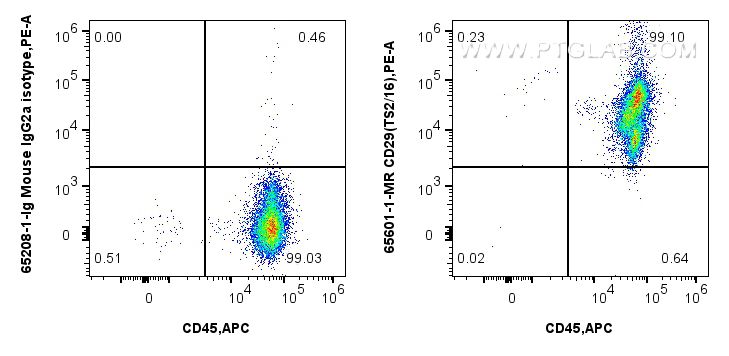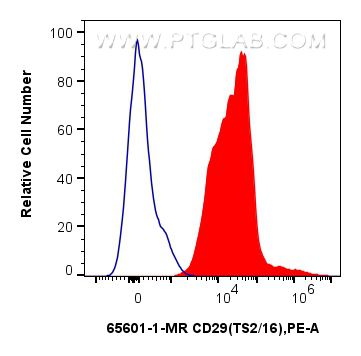Validation Data Gallery
Tested Applications
| Positive FC detected in | human PBMCs |
Recommended dilution
| Application | Dilution |
|---|---|
| Flow Cytometry (FC) | FC : 0.25 ug per 10^6 cells in 100 μl suspension |
| This reagent has been tested for flow cytometric analysis. It is recommended that this reagent should be titrated in each testing system to obtain optimal results. | |
| Sample-dependent, Check data in validation data gallery. | |
Product Information
65601-1-MR targets Integrin Beta 1/CD29 in FC applications and shows reactivity with human samples.
| Tested Reactivity | human |
| Host / Isotype | Mouse / IgG2a |
| Class | Recombinant |
| Type | Antibody |
| Immunogen | N/A 相同性解析による交差性が予測される生物種 |
| Full Name | integrin, beta 1 (fibronectin receptor, beta polypeptide, antigen CD29 includes MDF2, MSK12) |
| Calculated molecular weight | 88 kDa |
| GenBank accession number | BC020057 |
| Gene Symbol | Integrin beta 1 |
| Gene ID (NCBI) | 3688 |
| ENSEMBL Gene ID | ENSG00000150093 |
| RRID | AB_3670348 |
| Conjugate | Unconjugated |
| Form | |
| Form | Liquid |
| Purification Method | Protein A purification |
| UNIPROT ID | P05556 |
| Storage Buffer | PBS with 0.09% sodium azide{{ptg:BufferTemp}}7.3 |
| Storage Conditions | Store at 2-8°C. Stable for one year after shipment. |
Background Information
Integrin beta-1 (ITGB1), also named as CD29, is a 130 kDa single chain type I glycoprotein that is expressed in a heterodimeric complex with one of six distinct α subunits, comprising the very late activation antigen (VLA) subfamily of adhesion receptors. It is one of the essential surface molecules expressed on human MSC from bone marrow and other sources. The β1 subunit is also broadly expressed on lymphocytes and monocytes, weakly expressed on granulocytes, and not expressed on erythrocytes. These receptors are involved in a variety of cell-cell and cell-matrix interactions.
Protocols
| Product Specific Protocols | |
|---|---|
| FC protocol for Integrin Beta 1/CD29 antibody 65601-1-MR | Download protocol |
| Standard Protocols | |
|---|---|
| Click here to view our Standard Protocols |

